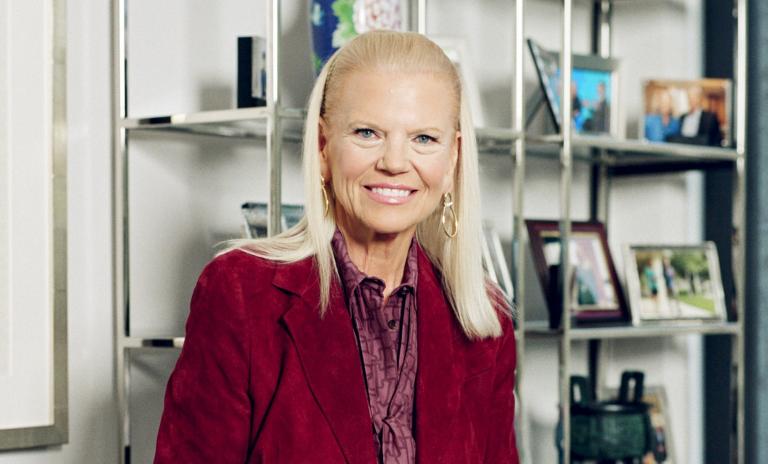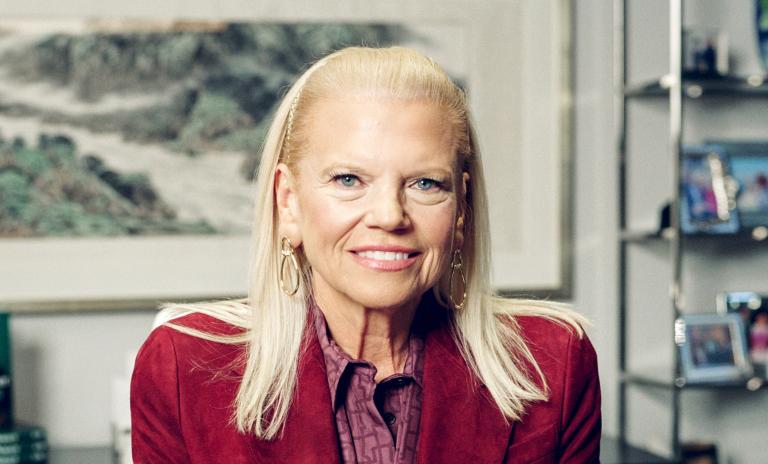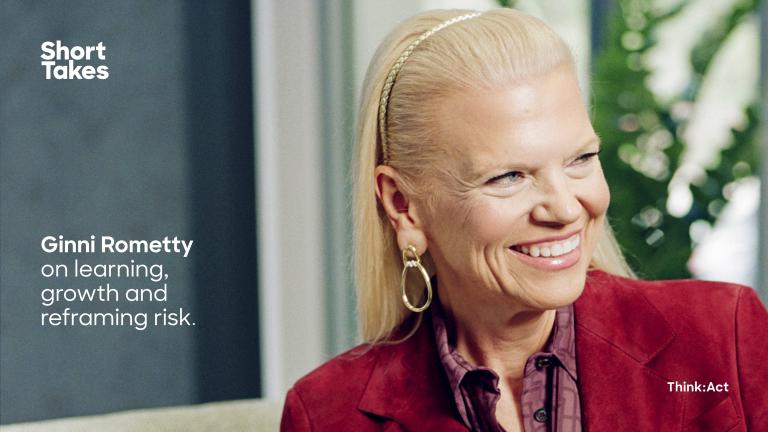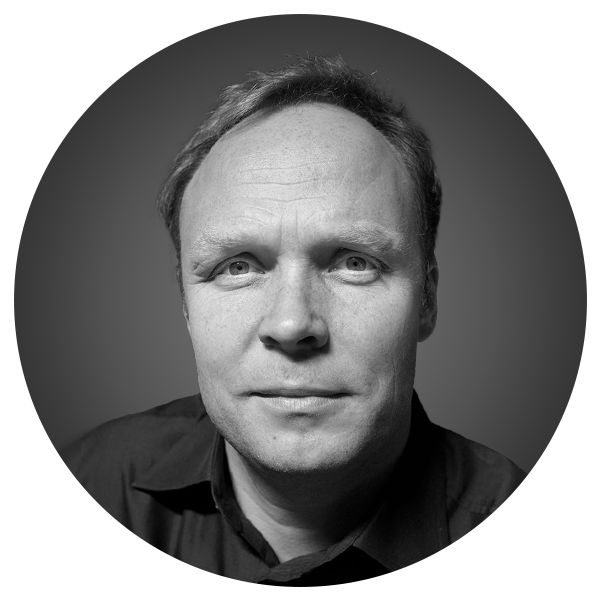It's time to rethink AI
![{[downloads[language].preview]}](https://www.rolandberger.com/publications/publication_image/ta42_en_cover_download_preview.jpg)
As our lives and work are increasingly being reshaped by AI, the new edition of Think:Act Magazine explores what this means for C-level managers.


by Steffan Heuer
Photos by Ysa Pérez
Ginni Rometty sat at the top of one of the world's most powerful businesses. But her leadership story didn't begin as IBM’s CEO. In her new book Good Power, she shares how a challenging childhood shaped her vision for the intelligent use of influence.
For executives writing their memoirs, it is rare to opt for the approach of delving into more painful parts of their past. Yet that is exactly how IBM’s former CEO Virginia, or "Ginni," Rometty opens her new book Good Power. Over the course of almost 40 years, the Chicago native worked her way up from an entry-level systems engineer to head of global sales, marketing and strategy before finally becoming CEO of the 100-year-old company in 2012. The experience of growing up in a fatherless household motivated Rometty to try to wield power for the greater good. "No matter how desperate a situation gets, we each have within us the power to create opportunity for ourselves as well as others," she recounts. In this remotely conducted conversation with Think:Act, Rometty reflects on how turning adversity into advocacy has become the guiding principle for her life, even long after leaving the executive suite in 2020.

Your legacy in business is impressive. Four decades at IBM, nine years in the rare category of a Fortune 500 CEO. Yet your book isn't a management manual, but rather a personal account. Why?
Good Power may not be a traditional business book, but lessons about business, careers and leadership are weaved throughout. To understand how I developed my career and why I made many decisions as IBM's CEO, it helps to understand where I came from and what I value. I think the best way to describe what I've written is a memoir with purpose, because I write about my experiences through the lens of ideas much bigger than me, but ones that I hope many people will relate to and use in their own lives.
Ginni Rometty became the first female CEO of IBM in 2012. During her nine-year transformation effort at the company, IBM built a $25 billion hybrid cloud business and established itself as a leader in AI and quantum computing. Her career-long commitment to innovation was recognized with the Edison Achievement Award in 2019. She currently serves on several boards and is co-chair of OneTen, an organization committed to upskilling, hiring and promoting Black Americans.
What does the title of the book mean to you?
Power is often perceived negatively because so many people have used power to harm versus to benefit the greater good – and for selfish purposes. Personally, I never really liked or used the word. But as I reflected on my life experiences for the book, I realized how often I had used my own power to help my family, my clients and IBM. I saw that power doesn't have to be bad to be potent. In fact, power is necessary to make things better. It's important to think about how to use power well, and wisely.
The three big pillars of your narrative are me, we and us. How do they relate to each other in the context of power?
I believe our power becomes more potent over time: Like a pebble tossed into a pond, our spheres of influence only widen. With experience we move from the "power of me," to the "power of we," to the "power of us." More specifically, when we're young, in school and beginning our working lives, we are more "me"-centric. Our mission as we grow into adulthood, as we adopt foundational values and character traits and take on more responsibilities, becomes less me and more about we. Our actions have consequences for others, like our partners, our children and the people and organizations we work with. At some point, we find ourselves in positions to effect positive change at real scale and our perspective expands to making us better – underserved groups, societies, countries, the environment, the world we share. This is how my own journey unfolded – from me, to we, to us.

Did your challenging childhood after your father left the family prepare you for leadership?
My father's absence began long before he left us. I took on a leadership role in my family as the eldest child, helping my mom raise my younger siblings because my dad was not home a lot. So, at an early age, I had a sense of accountability and responsibility which absolutely flowed into my character, and eventually my professional life. Once my father left and we had no money, I watched my mother muster the courage to go back to school and get jobs to help us pay for our home and food. She didn't let my father's actions define her life in a negative way, and I learned through her never to let anyone define you. That philosophy shaped me.
"Transformation is different than reinvention; understanding what elements must stay the same is critical."
What are the crucial lessons from your decisions to transform IBM in your nine-year tenure that are applicable to today's upheaval and disruptions?
First of all, we create meaningful change when our intention is to be in service of others. We do this by identifying and meeting their needs before or in parallel to our own. In the case of IBM, I had to make some tough decisions that met the needs of multiple stakeholders even if it meant I, personally, would be criticized. Second, we create change when we inspire people to pursue a purpose they authentically believe in. People must want to change, not be ordered to change. I spent a lot of time building people's belief in IBM's future by being honest about why we needed to change and by developing their skills so they could grow with us. A third way to enact change is by focusing not only on what must change, but what must endure.
Transformation is different than reinvention; understanding what elements must stay the same is critical. In the case of IBM, we knew we needed a new technology platform – in the cloud and for AI. But, we did not need a new purpose as a company; IBM's purpose had always been to be essential to our clients by running their complex, mission-critical systems. Whatever cloud technology we created had to do just that, keep us essential to clients.
What are the most important qualities a leader needs for tomorrow – and have they changed?
Wherever you are in your career, learn to be an Olympic learner. That is the best skill you can ever have. At IBM, it would eventually become what we'd change our hiring for: a propensity to learn over actual skills because it's changing so fast.
Tough decisions often mean conflict. What's your advice on how to handle that?
Embrace it! Choose to see conflict not as a setback, but as an opportunity to improve the status quo and strengthen relationships. Personally, confronting conflict reduces my own anxieties because my energy goes into solving versus stewing. Running toward conflict takes courage and often humility, but it's more productive than the alternative.

"Have confidence in the face of risk. If we want to advance in our careers, if we want to be better versions of ourselves, we will be uncomfortable at times – and that's OK."
How can you know how much to change and how much is too much?
All change requires hard choices about what things to preserve and what to reimagine. If you are trying to change careers, for example, the "what" may be your job, your industry or your employer. But you don't want to change your "what" so much that you abandon your values or can't be true to who you are by working for an organization with a mission you do not believe in. In the case of changing a company, the "what" may be its products and services. But like a person, a company doesn't want to lose its core identity. As someone once said to me, "IBM would make a horrible Google just as Google would make a terrible IBM."
The other thing I've learned about change is that "how" is as important as the "what." For a person switching jobs, they may have to go back to school to learn new skills and gain new knowledge. For a business to produce new products, it may have to upskill their workforce and teach them new ways of working. In short, change is never all or nothing, but a nuanced process. The goal is to become a better version of ourselves.
You say that "growth and comfort never coexist." Can you elaborate?
I have been saying that for years – it is something I learned early in my career. About 20 years ago, the senior executive I worked for was moving to a new position and he recommended me to replace him. I told him I needed more experience. "Just go to the interview," he said. I did and when I was offered the job, I hesitated to accept. I wanted to go home and talk to my husband. That night Mark listened as I told him about the new job. He said only one thing: "Do you think a man would have answered that way? I know you, Ginni … in six months you will be telling me how you are ready for the next challenge." Mark's point was not about gender differences, but about choosing to have confidence in the face of risk. The next morning I went back to work and accepted the promotion. The experience taught me that if we want to advance in our careers, if we want to be better versions of ourselves, we will be uncomfortable at times – and that's OK.
Technology often holds the promise of efficiency gains and the peril of displacing workers. What are your thoughts on the future of employment?
Technology will eliminate some jobs, but it will also change existing jobs and create new ones. Preparing the workforce to thrive in the digital age has been a priority and passion of mine for years. Providing access to education and training so people of all ages have the modern skills employers need is a responsibility of the public and private sector. Companies, colleges, governments, nonprofits, training organizations and other entities all play a role in helping ensure a majority of people can attain well-paying, family-sustaining jobs.
Years ago I coined the term "new-collar" to refer to the new categories of work and worker that tech has ushered in. The term describes jobs that are not the stereotypical manual labor, hourly wage jobs associated with blue-collar workers, or the managerial, administrative roles of white-collar workers. In a sense, new-collar jobs replace the middle-income jobs that for decades provided middle-class incomes, which are disappearing. New-collar jobs are real and waiting to be filled – and do not require traditional forms of education, like four-year degrees.
"You can't be what you can't see."
How should organizations, the education system and society respond to the looming disruptions in the workforce? How can we best prepare?
These institutions must change how they do things to accommodate the new realities of the digital economy. Another term I coined, "skills first," is about the systemic changes that must take place to accommodate new technologies and the new-collar jobs being created. For instance, employers must rethink how they recruit and promote. They must stop requiring four-year degrees for jobs that really don't require them. The rampant over-credentialing of jobs is leaving millions of talented people who never went to college out of the workforce. In a skills-first world, employers become "builders" versus just "buyers" of talent.
In turn, we need our educational institutions and governments to pave new educational pathways into the workforce, so people can learn the skills companies want.
Whenever a female CEO writes a book, a question that always comes up is about being a role model for other women. What is your view on that?
As I came up in my career, I did not see myself as a role model for other women, nor did I try to be one ... I just wanted to be seen for my work, not my gender. Then one year, after I finished giving a speech, a man in the audience came up to me. I assumed he had a question or comment on the material I'd presented. Instead, he said, "I wish my daughter could have been here." It was a moment of recognition: I was a female role model, whether I wanted to be or not.
I became cognizant that I was being viewed through that lens. I began to see myself in service of other women who wanted to build their own careers, or go into fields and jobs dominated by men and gain the confidence to believe they could because, perhaps, someone else had done it. You can't be what you can't see.

![{[downloads[language].preview]}](https://www.rolandberger.com/publications/publication_image/ta42_en_cover_download_preview.jpg)
As our lives and work are increasingly being reshaped by AI, the new edition of Think:Act Magazine explores what this means for C-level managers.
